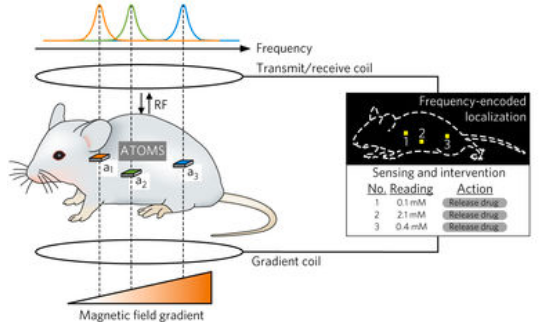Miniature MRI simulator chip could help diagnose and treat diseases in the body at sub-millimeter precision
September 13, 2017

Illustration of an ATOMS microchip localized within the gastrointestinal tract (not to scale; a prototype measures just 0.7 cubic millimeters). The microchip contains a magnetic field sensor, integrated antennas, a wireless powering device, and a circuit that adjusts its radio frequency signal based on the magnetic field strength and wirelessly relays the chip’s precise location. (credit: Ella Marushchenko/Caltech)
Caltech researchers have developed a “Fantastic Voyage” style prototype microchip that could one day be used in “smart pills” to diagnose and treat diseases when inserted into the human body.
Called ATOMS (addressable transmitters operated as magnetic spins), the microchips could one day monitor a patient’s gastrointestinal tract, blood, or brain, measuring factors that indicate a patient’s health — such as pH, temperature, pressure, and sugar concentrations — with sub-millimeter localization and relay that information to doctors. Or the devices could even be instructed to release drugs at precise locations.
An open access paper describing the new device appears in the September issue of the journal Nature Biomedical Engineering. The lead author is Manuel Monge, who now works at Elon Musk’s new Neuralink company.

The ATOMS microchips, proven to work in tests with mice, mimic the way nuclear spins in atoms in the body resonate to magnetic fields in a magnetic resonance imaging (MRI) machine and can be precisely identified and localized within the body. Similarly, the ATOMS devices resonate at different frequencies depending on where they are in a magnetic field. (credit: Manuel Monge et al./ Nature Biomedical Engineering)
Abstract of Localization of Microscale Devices In Vivo using Addressable Transmitters Operated as Magnetic Spins
The function of miniature wireless medical devices, such as capsule endoscopes, biosensors and drug-delivery systems, depends critically on their location inside the body. However, existing electromagnetic, acoustic and imaging-based methods for localizing and communicating with such devices suffer from limitations arising from physical tissue properties or from the performance of the imaging modality. Here, we embody the principles of nuclear magnetic resonance in a silicon integrated-circuit approach for microscale device localization. Analogous to the behaviour of nuclear spins, the engineered miniaturized radio frequency transmitters encode their location in space by shifting their output frequency in proportion to the local magnetic field; applied field gradients thus allow each device to be located precisely from its signal’s frequency. The devices are integrated in circuits smaller than 0.7 mm3 and manufactured through a standard complementary-metal-oxide-semiconductor process, and are capable of sub-millimetre localization in vitro and in vivo. The technology is inherently robust to tissue properties, scalable to multiple devices, and suitable for the development of microscale devices to monitor and treat disease.